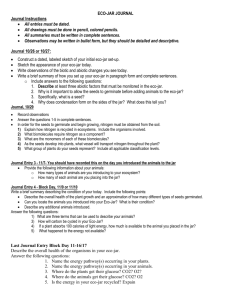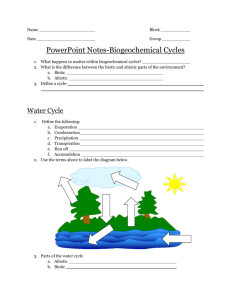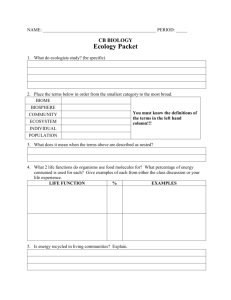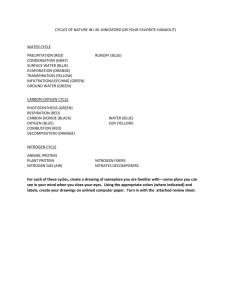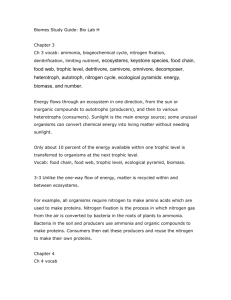Ecology_Abiotic_Fact..
advertisement
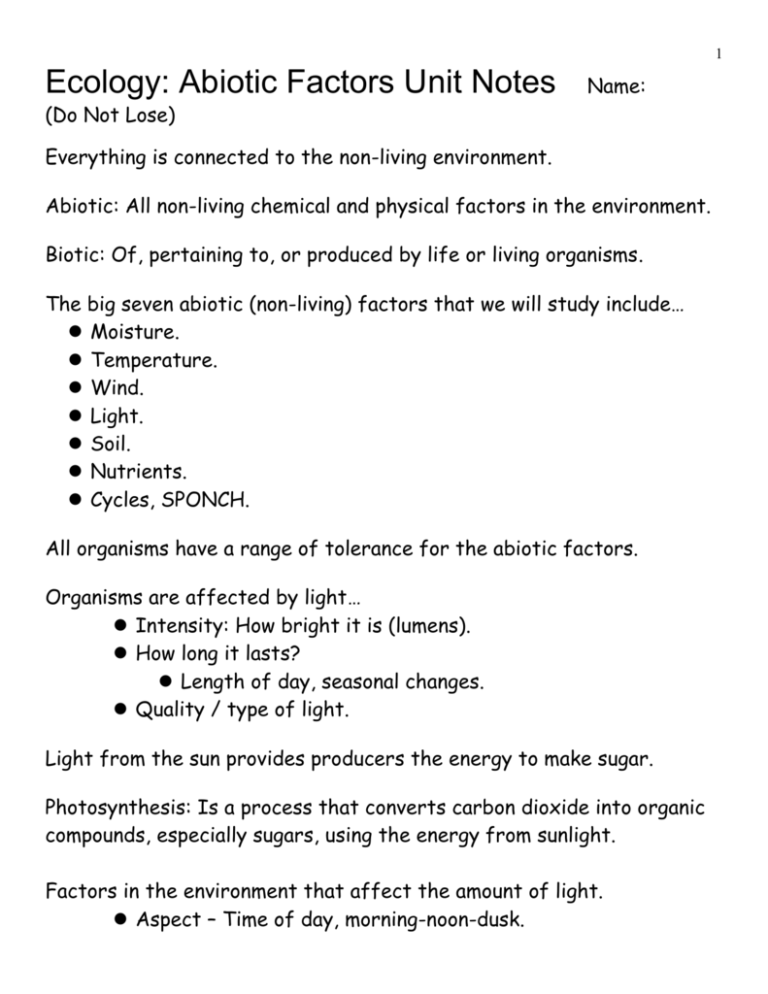
1 Ecology: Abiotic Factors Unit Notes Name: (Do Not Lose) Everything is connected to the non-living environment. Abiotic: All non-living chemical and physical factors in the environment. Biotic: Of, pertaining to, or produced by life or living organisms. The big seven abiotic (non-living) factors that we will study include… Moisture. Temperature. Wind. Light. Soil. Nutrients. Cycles, SPONCH. All organisms have a range of tolerance for the abiotic factors. Organisms are affected by light… Intensity: How bright it is (lumens). How long it lasts? Length of day, seasonal changes. Quality / type of light. Light from the sun provides producers the energy to make sugar. Photosynthesis: Is a process that converts carbon dioxide into organic compounds, especially sugars, using the energy from sunlight. Factors in the environment that affect the amount of light. Aspect – Time of day, morning-noon-dusk. 2 Crepuscular: When animals are active at dawn and at dusk. Cloud Cover. Seasons. Location on earth Light can also affect an organisms movement. Phototropism: The directional growth of plants in response to light. Phototaxis: The movement of an organism either towards or away from a source of light. Photokinesis – Movement based on the intensity of light. Bioluminescence: The production of light by a living creature. Can be used to attract and avoid. Temperature can affect organisms by… Causes flowers to open and close. Causing seeds to germinate. Causing some trees to drop their leaves. Affects activity of warm and cold bloodedness animals. Creating huge temperature swings in desert from day to night. Creating seasonal changes in temperature. Thermoregulation is the ability of an organism to keep its body temperature within certain boundaries. Range of tolerance. Two type of thermoregulation Physiological regulation. Behavioral regulation. 3 Adaptation: A process whereby an organism becomes better suited to its habitat. Characteristic which aids survival. Behavioral: Actions or reactions of an organism to the environment. Behavioral thermoregulation examples. Move to a warmer or cooler place. Change posture in one place. Expand your cells when you want to be warmer. Reptiles / Amphibians. Hibernation: Being inactive during winter, and lower metabolism Decreasing heart rate, blood flow. Adding layers Physiological: The functions of the body. Physiological adaptations to temperature. These you generally cannot control, your body does them automatically. Utilize evaporation. Changes in circulation of blood. Growing or losing insulation. Have thermal windows (Ears) Shivering: Muscles contract and relax when it is cold, this generates heat. Goosebumps: Skin muscles tighten, forming bumps, which cause your hairs to raise, trapping more air and keeping you warmer 4 Hypothermia - A decrease in the core body temperature to a level at which normal muscular and brain functions are impaired. Hyperthermia: Having a body temperature that is to high, causes heart failure, among other problems and death. Warm-bloodedness (endothermy): Maintaining a warm body temperature independent of environmental conditions. • Advantage: Warm-blooded animals can remain active in cold environments. • Disadvantage: Is that warm-blooded bodies provide an nice warm environment for viruses, bacteria and parasites to live in. Cold-Bloodedness: When organisms can’t regulate their internal temperature. When it’s cold they can’t move, when it’s warm their more active. Hibernation / torpor: A state of inactivity and metabolic depression in animals. (Slow breathing, lower body temp) Advantage: Cold-blooded animals require much less energy to survive than warm-blooded animals do. Disadvantage: They can’t be active in cold places during the winter. 5 New Abiotic factor: Water Water requirements and plants. Hydrophytes: Plants which grow in water. Mesophytes: Plants with average water needs. Xerophytes: Plants which grow in dry environments. Adaptations of plants to survive with minimal water include. •Using stomata: Structures that can close to keep water in when dry. •Thick waxy cuticles to keep water in (succulents, cacti) •Small leaves, or absence of leaves. •Water storage tissues. •Deep roots How animals have adapted to low water availability? •Body covering can limit water loss. – Skin vs. scales, insect chitin vs. feathers. • Body tissue that retain water. 6 • Some small animals can absorb water from the air in morning (dew), then go underground. – Rare desert frogs and some insects. • Eat prey items that are full of water. • Have really dry feces. • Come out only at night. Nocturnal. • Seek shade, and live underground. On the other end of the spectrum, too much water can hurt a plant or animal. Too wet will cause fungal growth. • Many tropical plants have drip tips so that water falls away from leaf and plant. New Abiotic Factor: Wind Wind is moving air and has a number of important functions in an ecosystem. – Some good, some bad. • Wind brings weather, especially precipitation. Water evaporates over ocean, wind carries water over land where it falls. • Wind can also cause erosion of soil, and will dry out areas much faster. • Eroded soil can be redistributed to an area that needs it. • Wind can be very damaging to plants and animal populations. 7 • Wind also increases the intensity of wild fires. • Animals and plants use wind in many ways. Animals use wind… To smell. Water, prey items, predators, etc. To fly with minimal effort. To move. To dry out and also to cool down. Plants use wind To pollinate. Pollination: The transferring of pollen (plants sex cells) from one plant to another. To disperse seeds. Plants can disperse seeds by… Wind. Water. Animal. Tension. Fire. Water Dispersal: The seeds or fruits are dropped from the plant into rivers, lakes or seas. They, being less dense than water, float and some of them can germinate upon being washed up on land. Island Biogeography: The study of rates of colonization and extinction of species on islands. 8 MacArthur-Wilson Equilibrium Theory Island size and distance from mainland determine level of migrations and the rate of extinctions on the island. Animal seed dispersal: When animals aid carrying away seeds. Animal dispersal. Review - Animals help disperse pollen to fertilize plants. They carry and drop seeds. Seeds sometimes stick to an animal and hitch a ride to fall off later and in a new location. Animals hide stashes of seeds and then forget where. Animals eat fruits that contain seeds. They then pass out the seeds many hours later into a nutrient rich, moisture retaining, pile of feces far from plant. Humans spread seed crops. Tension dispersal. Abiotic – doesn’t involve animals. Tension builds and seeds are ejected a short distance. Fire: Some seeds require a fire event or very hot temperature after they have been dispersed to germinate. Fire ecology: A branch of ecology that focuses on the origins of wildland fire and its relationship to the environment that surrounds it, both living and non-living. Fire Dependence: This concept applies to species of plants that rely on the effects of fire to make the environment more hospitable for their regeneration and growth. 9 New Area of Focus: Biogeochemical Cycles. Biogeochemical Cycles. Bio – Life Geo – Earth Chemical – Changes in atoms / molecules Cycles – Repeated event, full turn. A general theme for all of the biogeochemical cycles we will study. They go from the living world (biotic) to the non-living (abiotic). The biogeochemical cycles we will study. Water cycle. Carbon cycle. Phosphorus cycle. Nitrogen cycle. The hydrologic cycle: The continuous movement of water on, above, and below the surface of the earth. 10 Evaporation – Substance changes from a liquid state to gas state (requires energy). Condensation – Water vapor (gas) turns back to a liquid. (energy required / cold) -cloud formation. Precipitation – Water that is so heavy it falls as liquid / solid. Sublimation – Solid state turns directly to a gas state skipping liquid phase. Transpiration – Water released by plants into air. Non-living to the living, and back again. 11 Surface run-off: The water flow which occurs when soil is full to capacity and excess water travels over the land. Percolation: The slow movement of water through the soil. Groundwater discharge: Water that has been underground seeps back into the oceans, or into rivers or lakes. Carbon Cycle: The circulation of carbon from the atmosphere into organisms (biotic) and back again (abiotic). Carbon travels through organisms and back to the non-living world. It’s goes through the air, land, and oceans. Photosynthesis – Plants make sugar from sunlight. Light energy is turned into chemical energy (sugars – carbon based). 6CO2 + 6H2O + light energy = C6H12O6 + 6O2 Photosynthesis Produces sugars from energy. Occurs only in cells with chloroplasts. Oxygen is produced. Water is used. Carbon dioxide is used. Occurs in light. 12 Cellular Respiration: Processes whereby certain organisms obtain energy from organic molecules. Cellular Respiration C6H12O6 + 6O2 = 6CO2 + 6H2O + released energy. Respiration Burns sugars for energy. Energy is released. Occurs in most cells. Oxygen is used. Water is produced. Carbon dioxide produced. Occurs in dark and light. 13 The carbon dioxide oxygen balance. Plant uses carbon dioxide and produces oxygen (photosynthesis). Animal uses oxygen and produces carbon dioxide (respiration). 14 New Biogeochemical Cycle: The Nitrogen Cycle. Nitrogen Cycle: The circulation of nitrogen; nitrates from the soil, absorbed by plants, eaten by animals that die and decay returning the nitrogen back to the soil. Nitrogen in atmosphere is inert (N2 Gas) which is not reactive. (Can’t use) Bacteria on plant roots convert nitrogen in atmosphere into nitrate ions (NO3−) (NO2-) ammonia (NH4) Plants now have usable nitrogen. 15 Animals get nitrogen from eating plants. Animals and plants release nitrogen in waste such as urea (NH2)2CO and death. Bacteria break down nitrogen and release it back into air as N2 Gas. Called (Denitrification). Water in a pure state has a neutral pH. As a result, pure water is neither acidic nor basic. pH scale goes 1-14 7 is neutral or very little pH 1 is Acidic 14 is basic pH - An expression for the effective concentration of hydrogen ions in a solution. 1 is very acidic and 14 is basic. 7 is considered neutral. The strength of an acid is based on the concentration of H+ (hydrogen) ions in the solution. 16 Acid Rain is caused by Nitrogen and Sulfur dioxides. Aka – Air pollution. Acid Rain: Rainfall made sufficiently acidic by atmospheric pollution such as burning coal and from car exhaust that causes environmental harm, typically to forests and lakes. 17 Phosphorus cycle: The biogeochemical cycle that describes the movement of phosphorus through the lithosphere, hydrosphere, and biosphere. Importance of phosphorus Important nutrient for plants and animals. Part of DNA molecule in our cells. In the fats of our cell membrane. Part of our bones and teeth. 18 Area of focus: Nutrients and Aquatic Systems. Eutrophic • Having concentrations of nutrients optimal or for plant or animal growth. It is used to describe nutrient or soil solutions. • Mesotrophic Production is considered moderate. Olgiotrophic Describes a lake or river with low productivity. Eutrophication Aquatic plants use Phosphorus and Nitrogen and grow out of control. Aquatic plants overpopulate and die. Bacteria break down dead plants and use oxygen in water (respiration). No oxygen left for fish / other aquatic life and they die. SAVE THESE NOTES FOR THE OFE! DO NOT LOSE! Copyright © 2010 Ryan P. Murphy 19

